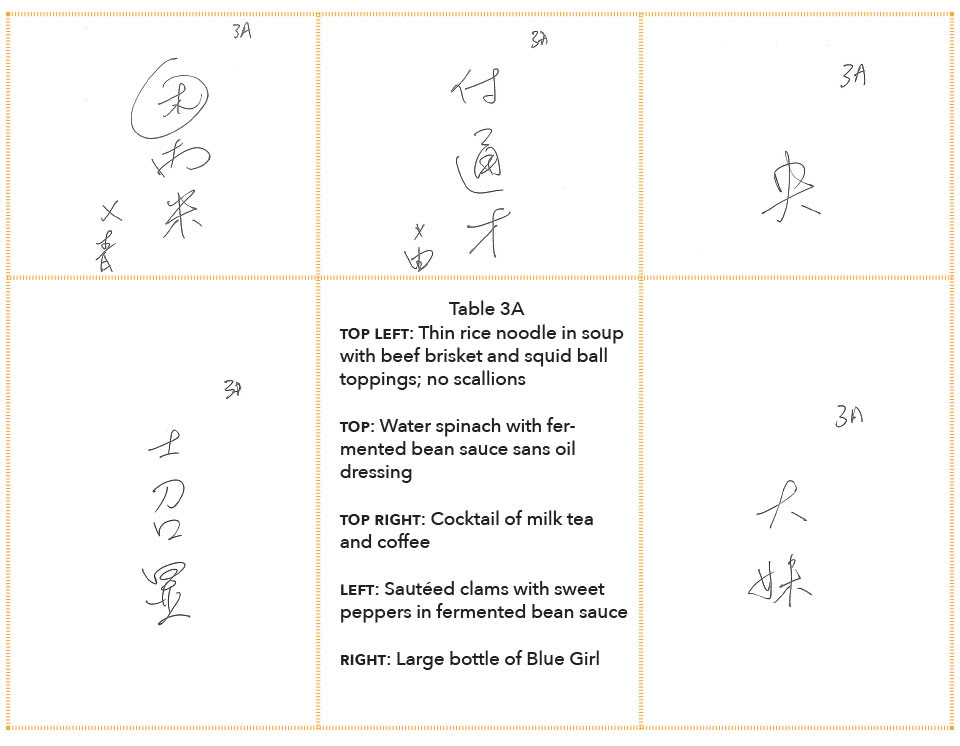Chinese restaurant shorthand, part 6
« previous post | next post »
In "Hong Kong Food Runes", World Literature Today (Spring, 2019), Lian-Hee Wee takes a highly literate look at the semiliteracy of Hong Kong restaurant workers. This is a different view from our earlier investigations on this topic, since Wee is writing from the vantage of a waiter who is intimately familiar with this stenographic script. Below is a set of order slips for Table 3A at a daai paai dong (lit., "big row of stalls", i.e., "hawker center"):
Since Wee eloquently and explicitly explains the meaning of the symbols on this particular set of order slips, I'll let him speak for himself:
No, there aren’t a million different symbols. There are principles underlying these runes. In the first slip above, the 木 is a Chinese character meaning wood, which is nearly homophonous with “ink,” itself encircled so that it stands for ink ball (→squid ball). 米 is the character for “(uncooked) rice,” which is what is used to make thin rice noodles. The strange cap above it is the first few strokes of 南, homophone for brisket. The ✗ in the bottom is a negator, and 青 means “green” (→scallions). The other slips contain similar cryptography that speaks of the ingenuity of maximizing minimum literacy. 央 in the third slip is an extraction from the second character of 鴛鴦 “Mandarin ducks,” which are romantically believed to come in monogamous pairs. The eroticism of stirring one fluid into another to make a blend out of two beverages injects an unspoken humor to mitigate the dread of this onerous work. By combinations of simple homophonous characters, and by extractions of distinctive ideographic shapes, a semiliterate waiter can speedily write what remains remarkably legible to the similarly semiliterate kitchen. In my case, shuttling between stalls in a daai paai dong, I must be able to produce unambiguous order chits for what likely amounts, without exaggeration, to potentially about 10 million items. So what is real literacy anyways?
Closing note
Given our recent discussion of "squiggles", I thought this remark by the author was particularly à propos: "This quick script is no secret; we’ve all watched waiters scribble across their wafer-thin pads, but what waiter’s got the time to explain the squiggles?"
Readings
- "Chinese restaurant shorthand" (9/22/16)
- "Chinese restaurant shorthand, part 2 " (11/30/16)
- "Chinese restaurant shorthand, part 3 " (2/25/17)
- "Chinese restaurant shorthand, part 4" (4/21/17)
- "Chinese restaurant shorthand, part 5" (5/15/19)
- "Hong Kong-specific characters and shorthand" (3/15/15), with links to relevant websites for restaurant shorthand characters
- "General Tso's chikin" (6/11/13), especially in the comments
- "Writing: from complex symbols to abstract squiggles" (6/11/19)
[h.t. Stephen Dodson]

Joseph Bottum said,
June 17, 2019 @ 5:15 pm
"the ingenuity of maximizing minimum literacy"—that's a great phrase from Lian-Hee Wee. Worth the price of entry to the essay, even for those who don't know much about Chinese writing.